Tired of thinking you need a gym membership or a rack of weights cluttering your living room to get strong? Frustrated by workout plans that demand expensive gear you don’t have? Discover 7 proven bodyweight moves.
Let’s clear the air right now: You absolutely can build muscle, achieve impressive strength training results, and transform your body calisthenics for beginners using nothing but your own bodyweight..
This isn’t a beginner-only trick or a temporary fix; strength training without equipment (often called calisthenics or bodyweight exercises) is a potent, time-tested exercise method. It leverages gravity and your body weight to forge full-body strength, improve movement quality, and build resilience – without any equipment needed.
Consider this your liberating blueprint to effective strength training exercises you can do anywhere, proving you can build muscle at home and build strength on your own terms.
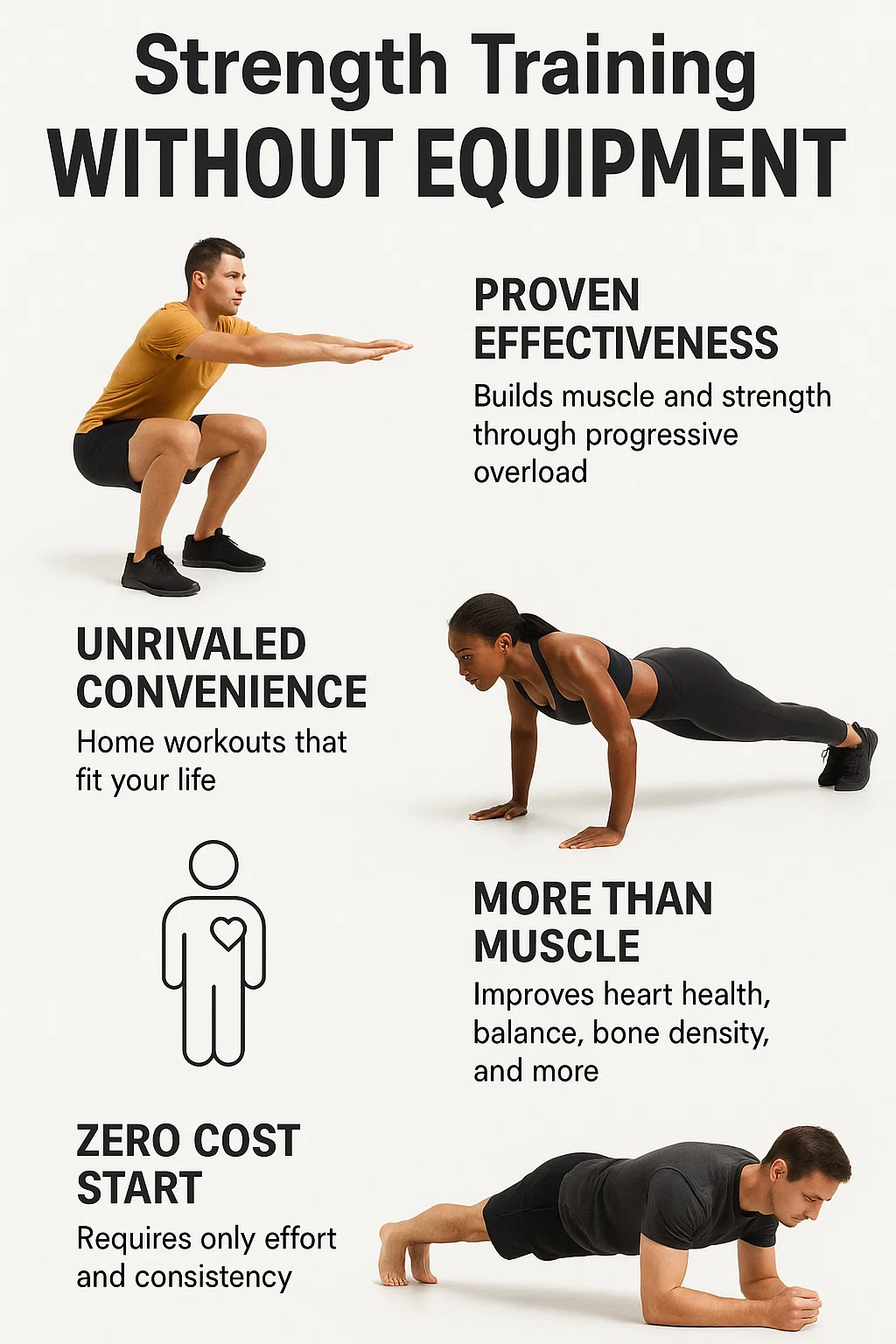
Key Takeaways
- Proven Effectiveness: Bodyweight exercises are scientifically validated to build muscle and build strength through progressive overload. Your body weight is the resistance.
- Unmatched Accessibility: This is the ultimate at-home workout, park workout, travel workout. No more excuses. Learn how to make fitness a part of your lifestyle with this freedom.
- Holistic Benefits: More than just aesthetics. Improves heart health, balance, bone density, metabolic function, and essential core strength.
- Infinitely Scalable: Perfect for those starting their fitness journey, yet offers endless progression for seasoned athletes aiming for peak bodyweight strength.
- Body Intelligence: Learn to interpret your body’s signals – fatigue, soreness, pain – for smarter training and injury prevention.
- Zero Cost Start: Your primary investment is effort and consistency. The ultimate strength training workout can start now.
Why Bodyweight Strength Training? Cutting Through the Hype
The fitness world often feels like a high-pressure sales pitch, pushing gear and supplements you probably don’t need. But think about it: humans evolved over millennia moving their own bodies through space. Pushing, pulling, squatting, lunging – these are fundamental patterns. Bodyweight exercise reconnects you with this innate capability, offering a raw, effective path to strength training without weights.
How You Build Muscle Without Weights
The core principle is progressive overload. You build muscle when you consistently challenge it to do more than it’s used to. With bodyweight exercises, you achieve this not by adding weight plates, but by manipulating factors like:
- Leverage: Changing your body angle makes an exercise harder or easier (think incline vs. decline push-ups).
- Stability: Moving from two limbs to one leg dramatically increases the demand.
- Tempo: Slowing down the movement (especially the lowering phase) increases time under tension, a key driver of muscle hypertrophy.
- Volume: Doing more reps or sets over time.
- Range of Motion: Increasing how far you move in an exercise (e.g., deeper squat). Your muscles respond to tension, regardless of its source. Bodyweight provides ample tension when exercises are chosen and progressed intelligently, making it a powerful tool to build muscle at home.
Unrivaled Convenience: Home Workouts That Fit Your Life
This is perhaps the most significant advantage. No commute. No waiting lines. No gym membership fees. Bodyweight exercise molds to your schedule. Early morning? Lunch break? Hotel room? Your workout is always available. It dismantles the most common barriers to consistent strength training exercises, making effective training at home a practical reality. This is fitness without a gym.
More Than Muscle: The Deeper Health Gains
Yes, you’ll build strong muscles and likely improve your physique. But the benefits of this type of resistance training are far-reaching.
Vigorous circuits elevate heart rate, boosting cardiovascular health. Weight-bearing movements enhance bone density. Increased lean muscle mass supports a healthier metabolism.
Crucially, mastering bodyweight control develops exceptional balance, coordination, and functional strength – strength that translates directly to moving better and feeling better in everyday life.
Lower Body Bodyweight Exercises: Squat, Lunge & More
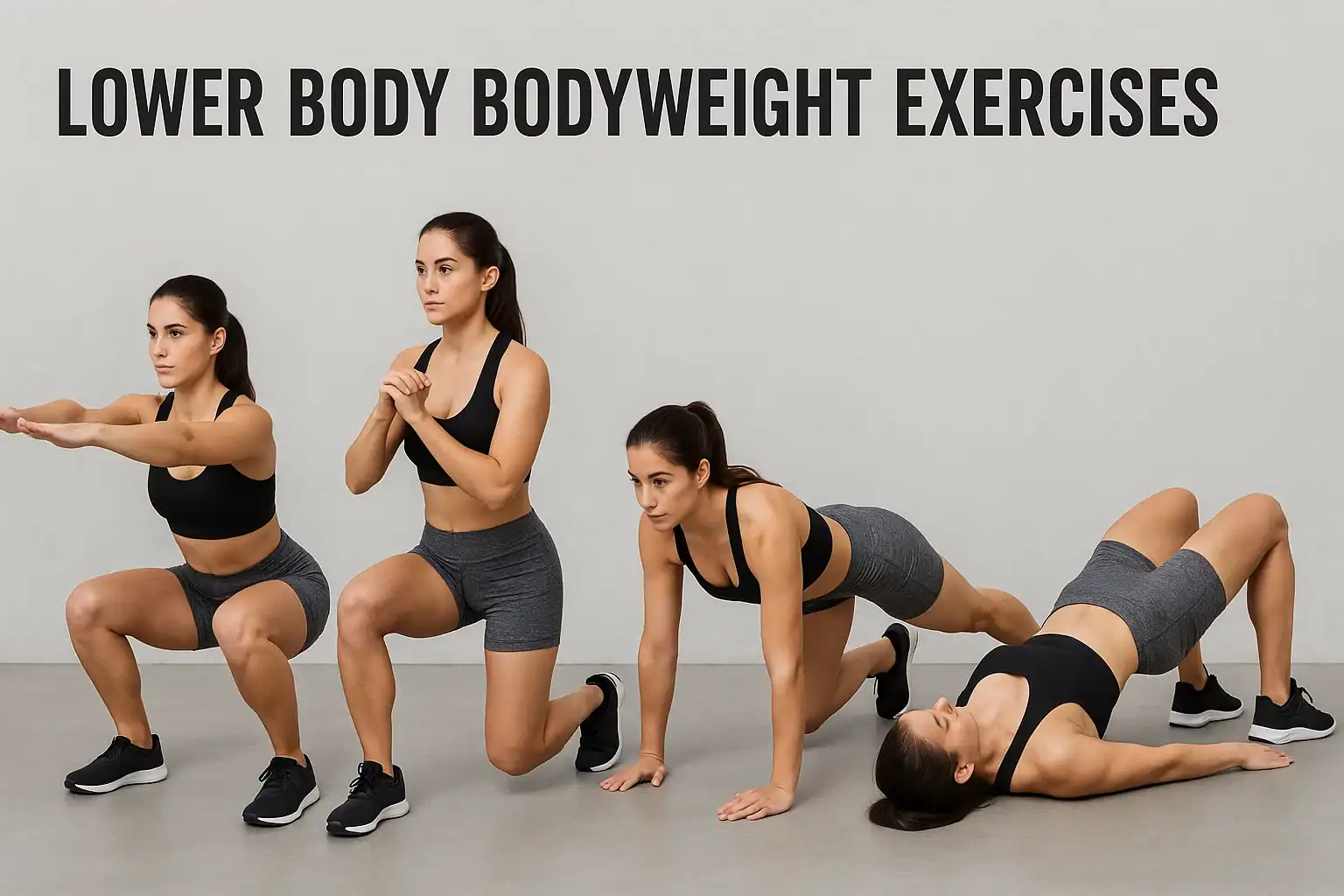
Your legs and glutes contain your body’s largest muscle group areas. Training them effectively fuels metabolism and builds foundational power. This is a key part of any full-body strength workout.
- Bodyweight Squat: The cornerstone lower body movement.
-
- How: Stand with feet shoulder-width, toes slightly out. Chest up. Initiate by pushing hips back as you bend your knees. Keep core muscles tight and keep your back straight (neutral spine). Lower until thighs are parallel to the floor or deeper, maintaining form. Drive powerfully back to the starting position.
- Progress: Deeper, slower tempo, paused holds, Jump Squats, single-leg variations (Pistol Squats).
- Lunge: Builds single-leg strength and stability.
-
- How: Step forward with right leg. Lower hips until both knees near 90 degrees. Front knee over ankle, back knee near floor. Torso upright. Push off right foot back to the starting position. Alternate with left leg. Consider Walking lunges for dynamic movement.
- Progress: Reverse Lunges, Lateral Lunges, Jump Lunges, Bulgarian Split Squats (rear foot back on elevated surface).
- Glute Bridge: Targets glutes and hamstrings effectively.
-
- How: Lie on back, knees bent, feet flat on the floor. Drive through heels, lift hips, squeeze glutes intensely at the top. Avoid over-arching the lower back. Lower with control.
- Progress: Single leg glute bridge (lift your right leg or left, keeping hips level), add pauses, marches, elevate feet.
A strong, balanced upper body is essential. Bodyweight offers fantastic options.
- Push-up: The benchmark chest, shoulder, and tricep builder; also a core stability exercise.
-
- How: Hands slightly wider than shoulders. Straight line head-to-heels. Lower chest towards floor, elbows tracking back ~45 degrees. Push back to the starting position. Engage your core muscles throughout.
- Progress: Incline -> Knee -> Full -> Decline -> Diamond -> Archer -> One leg -> One-Arm progressions. Aim for quality repetitions.
- Pulling Movements (Requires Something): Crucial for back and biceps, balancing push work. Use a sturdy table edge, low bar, rings, or even a strong towel/sheet anchored securely.
-
- How (Inverted Row): Lie under table/bar. Grip edge. Pull chest towards hands, keeping body straight. Lower slowly. Adjust feet to change difficulty.
- Progress: Pull-ups (if you have a bar), Ring Rows, single-arm row variations.
- Dips (Requires Parallel Bars/Chairs/Bench): Excellent resistance training for triceps, chest, shoulders.
-
- How: Hands on edges. Lower body by bending elbows straight back. Press powerfully back to the starting position.
- Progress: Feet supported -> Feet elevated -> Full dips -> Weighted dips (if possible).
Core Exercises for Bodyweight Strength
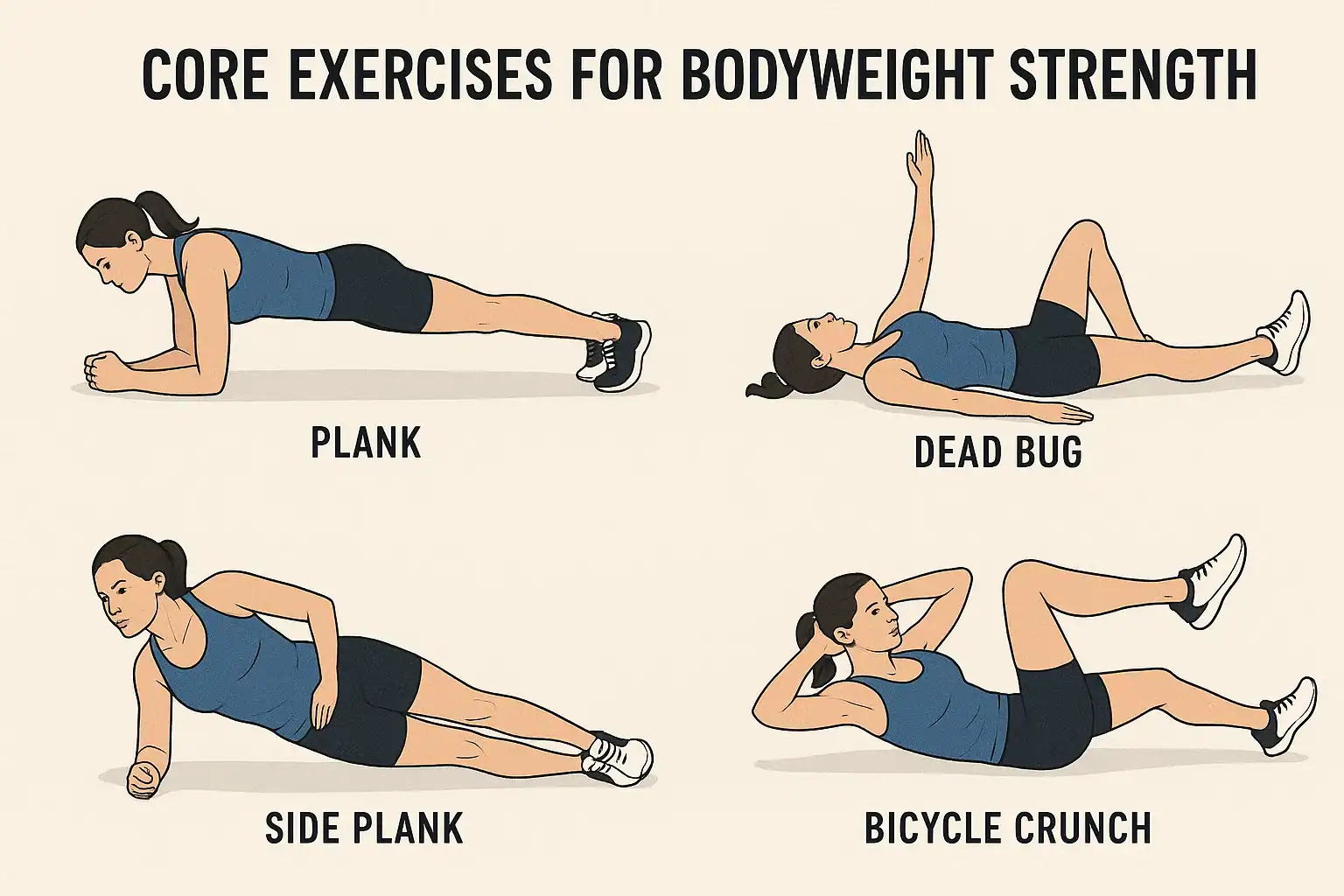
A strong core is your center of power and stability. Go beyond basic crunches with these effective core exercises.
- Plank & Variations: Builds isometric endurance and teaches core bracing.
-
- How: Forearm or high plank position. Rigid line head-to-heels. Brace abs, squeeze glutes. Breathe!
- Progress: Longer holds, Side Planks, Plank with alternating leg lift / arm lift, Plank Jacks.
- Bird Dog: Enhances anti-rotation stability and coordination.
-
- How: All fours, neutral spine. Extend opposite arm and leg (right leg / left arm, then left leg / right arm) without shifting torso. Hold briefly. Return slowly. Keep your back straight.
- Progress: Slower movement, hold longer, perform from plank position (advanced).
- Leg Raises: Targets lower abdominal muscles.
-
- How: Lie on back. Legs straight (or slightly bent). Lower legs slowly only as far as lower back stays down. Control is key. Avoid momentum.
- Progress: Straighter legs, slower tempo, add hip lift (Reverse crunch), Hanging Leg Raises (requires bar).
Build Muscle and Strength: The Progression Principle
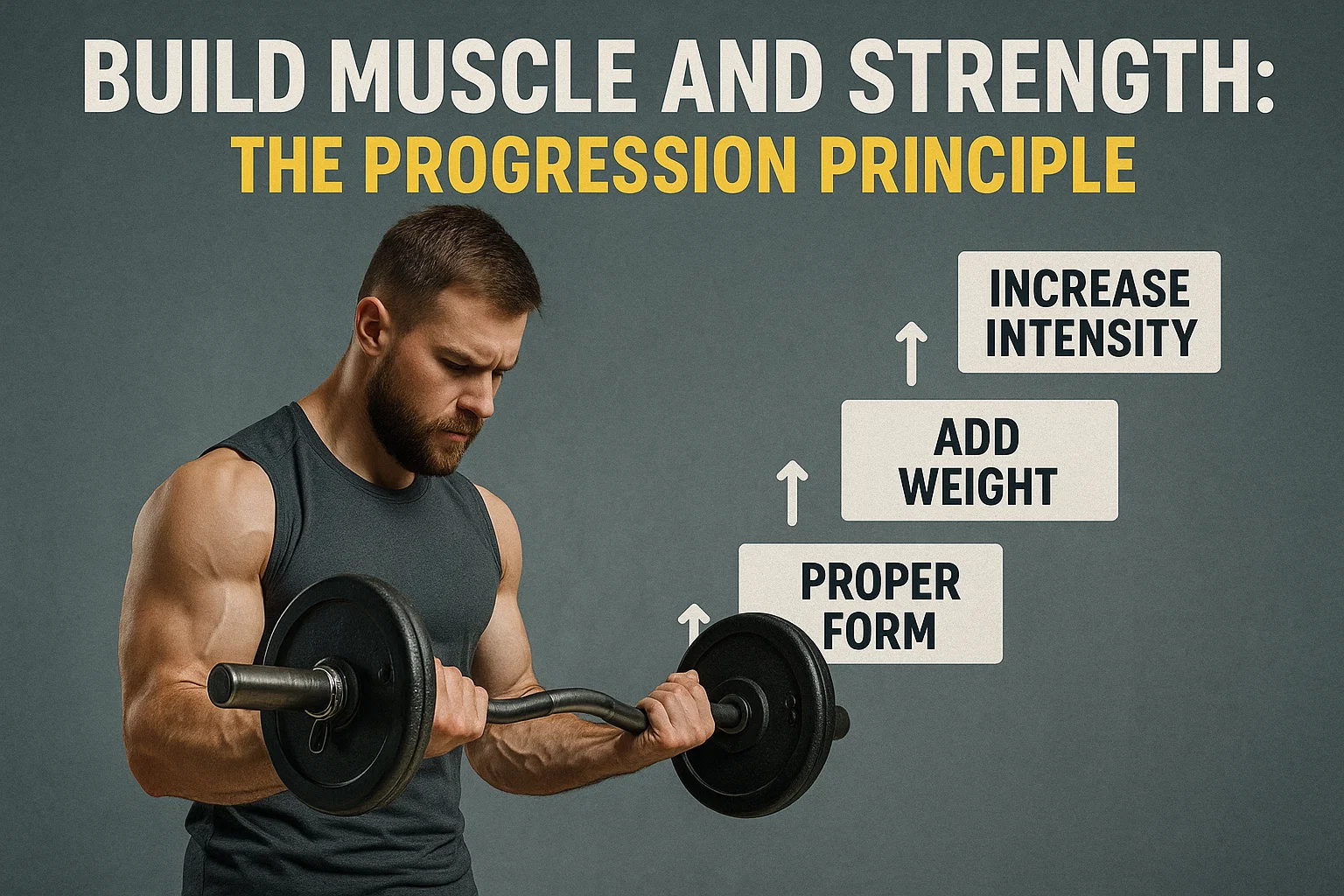
Simply doing the same bodyweight exercises forever won’t continuously build muscle or build strength. Progressive overload is essential. This means systematically making your home workouts harder over time.
How?
- Better Leverage: Make the bodyweight move mechanically harder (e.g., elevate feet for push-ups).
- Slower Tempo: Increase time under tension, especially on the lowering phase. Slowly lower your body.
- Pause/Hold: Pause at the hardest point of the exercise.
- Unilateral Work: Move to one leg or one arm variations.
- Increase Density/Volume: More reps/sets, less rest. Consider interval training structures.
- Complexity/Plyometrics: Combine moves (Burpees), add jumps (Jump Squats). Master basics first.
- (Optional) Minimal Gear: Eventually, a resistance band or weighted vest can add challenge [20]. Check out the best resistance bands for home workouts.
[PERSONAL EXPERIENCE] The Plateau and The Shift
I hit a wall with push-ups. Could bang out 20-25 decent reps, but wasn’t getting stronger. Adding more reps felt tedious and wasn’t translating to harder variations. The shift came when I stopped chasing reps and focused on difficulty. I elevated my feet (decline push-ups).
Suddenly, 10 reps felt brutal. I slowed down the negative – taking 3-4 seconds to lower. Even fewer reps, but the quality of tension was higher. Within weeks, I felt stronger, and moving towards archer push-ups felt possible.
It taught me that progression isn’t always linear or about volume; often, it’s about increasing the intensity of each rep through technique and leverage. This critical thinking applies to all strength exercises.
Your Bodyweight Workout Plan: Getting Started
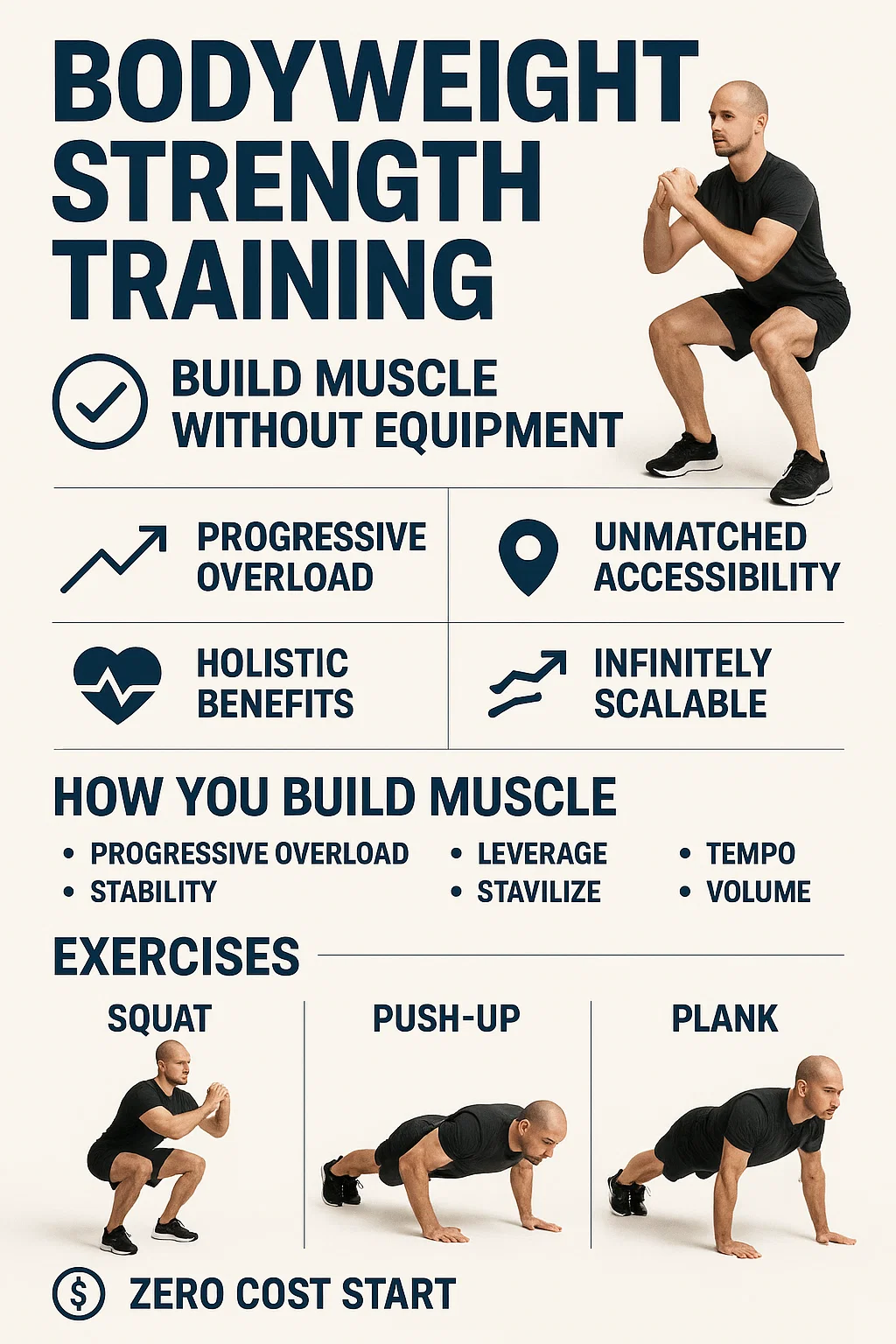
Knowledge needs action. Use these templates as a foundation for your workout plan. Adapt reps/sets/variations to your current ability. Form always comes first. Learn how to set fitness goals to make your plan specific.
Beginner Bodyweight Workout (Focus: Form)
- Goal: Learn movements, build baseline bodyweight strength.
- Frequency: 2-3 times per week, full body.
- Sample:
-
- Warm-up (5 min): Light cardio, dynamic stretches. See Stretching 101.
- Bodyweight Squats: 3 sets x 10-15 reps
- Incline / Knee Push-ups: 3 sets x AMRAP (stop before form fails)
- Alternating Lunges: 3 sets x 8-12 reps per leg
- Plank: 3 sets x 30-60 sec hold
- Glute Bridges: 3 sets x 15-20 reps
- Cool-down (5 min): Static stretches.
Intermediate Bodyweight Workout (Focus: Build Strength)
- Goal: Increase strength, build muscle, improve work capacity.
- Frequency: 3-4 sessions/week. Can split up the workouts (Upper/Lower) or keep full body.
- Sample Full Body:
-
- Warm-up (5-10 min): Dynamic movements.
- Squat Variation (Tempo, Paused): 4 sets x 10-15 reps
- Standard Push-ups: 4 sets x AMRAP
- Walking Lunges: 4 sets x 10-15 reps per leg
- Plank Variation: 4 sets x 45-75 sec / 10-15 reps
- Single-Leg Glute Bridges: 3 sets x 10-15 reps per leg
- Inverted Rows / Pull-up Negatives: 3 sets x AMRAP / 5-10 reps
- Cool-down (5-10 min). Learn how to recover from workouts.
Advanced Bodyweight Workout (Focus: Performance)
- Goal: High-level strength exercises, skill mastery.
- Frequency: 3-5 sessions/week. Usually split routines.
- Sample:
-
- Warm-up (10-15 min): Mobility, skill-specific prep.
- Advanced Lower Body (Pistol Squat progressions, Shrimp Squats): 4 sets x 3-8 reps
- Advanced Push (Handstand Push-up progression, Archer Push-ups): 4 sets x 5-10 reps
- Advanced Pull (Muscle-up progression, One-Arm Row progression): 4 sets x AMRAP/low reps
- Advanced Core Exercises (Dragon Flags, L-sits): 3 sets x AMRAP/Max Hold
- Cool-down (10+ min): Targeted stretching.
Long-Term Success: Mindset, Consistency, Listening
The best strength training exercises mean nothing without consistency.
- Discipline > Motivation: Motivation fades. Habits stick [66]. Show up. Do the work. Find ways for how to stay motivated to work out.
- Listen Intently: Distinguish muscle fatigue (good) from joint pain (bad). Respect rest days. Learn your body’s limits and signals. Smart training helps how to avoid injuries while working out.
- Fuel Properly: Support your home workouts with good nutrition. Learn how to eat healthy for fitness.
Final Thoughts: Own Your Strength Training
You don’t need permission or fancy gear to get strong. Strength training without equipment puts the power squarely in your hands. It’s honest work that builds functional strength, resilience, and deep body awareness.
Master the basics, apply intelligent progression, listen to your body, and be consistent. Your full-body strength workout awaits. Go claim it.
References
- Mayo Clinic – Strength Training: https://www.mayoclinic.org/healthy-lifestyle/fitness/in-depth/strength-training/art-20046670
- American Council on Exercise (ACE Fitness) – Bodyweight Exercise Library: https://www.acefitness.org/resources/everyone/exercise-library/?bodypart=0&equipment=10
- National Strength and Conditioning Association (NSCA): https://www.nsca.com/
- PubMed Central (PMC): https://www.ncbi.nlm.nih.gov/pmc/
- Nerd Fitness – Beginner Body Weight Workout: https://www.nerdfitness.com/blog/beginner-body-weight-workout-burn-fat-build-muscle/
- Start Bodyweight – Exercise Progressions: http://www.startbodyweight.com/p/exercise-progressions_12.html
- Reddit r/bodyweightfitness Wiki: https://www.reddit.com/r/bodyweightfitness/wiki/kb/recommended_routine/
- Harvard Health Publishing – Advantages of Body Weight Exercise: https://www.health.harvard.edu/exercise-and-fitness/the-advantages-of-body-weight-exercise
Alexios Papaioannou
Mission: To strip away marketing hype through engineering-grade stress testing. Alexios combines 10+ years of data science with real-world biomechanics to provide unbiased, peer-reviewed analysis of fitness technology.
